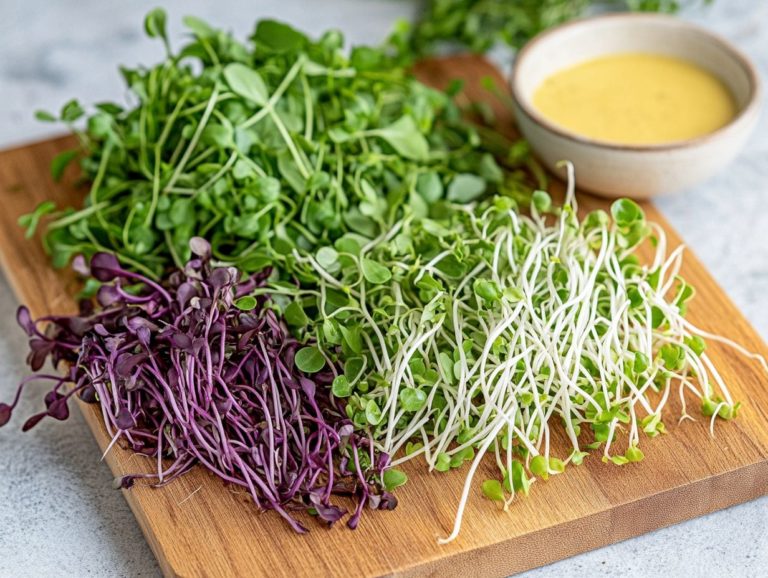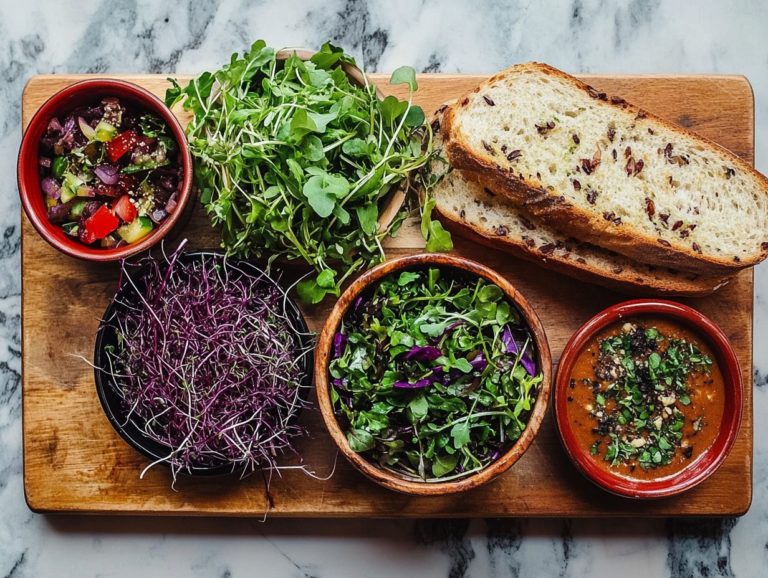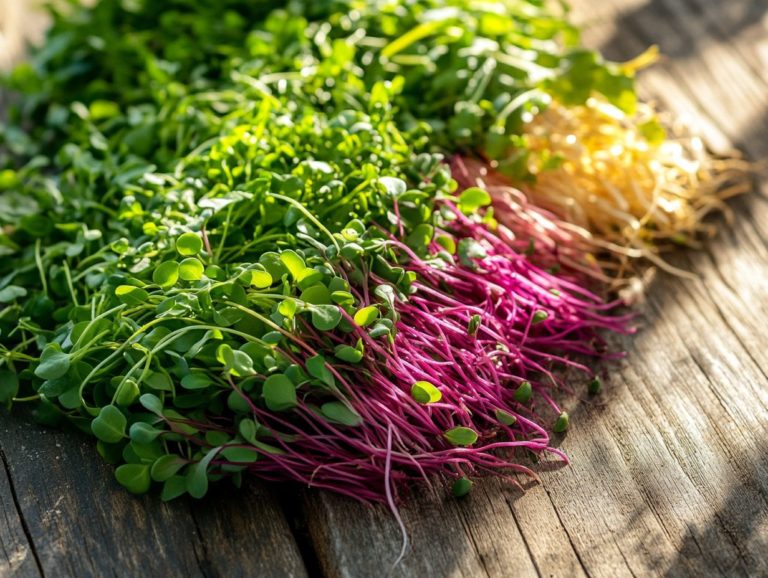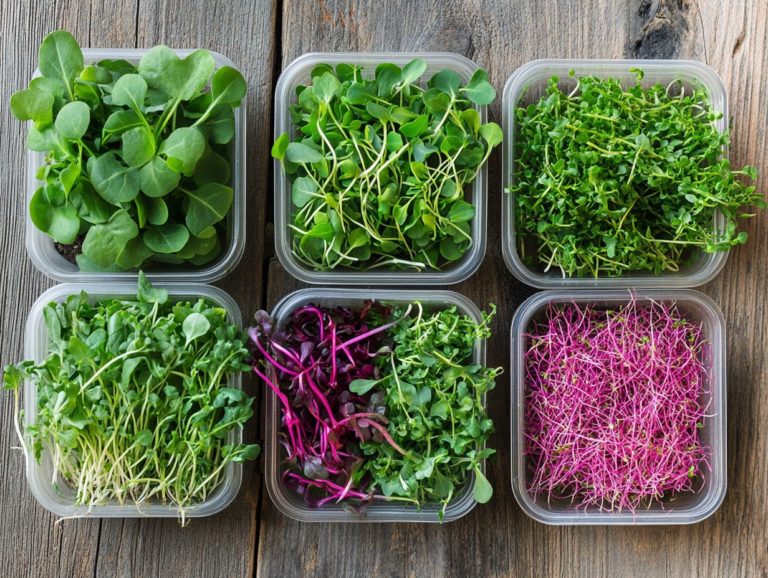How to Store Different Microgreen Varieties
Storing microgreens properly is crucial for preserving their freshness, flavor, and nutritional value, making them a true superfood!
This article delves into fundamental storage guidelines, emphasizing ideal temperature and humidity conditions necessary to keep your greens vibrant, ensuring their nutritional value remains intact.
You’ll explore specific storage methods tailored to various microgreen types, from herbs to root vegetables, and uncover some inventive alternatives.
You’ll also find valuable tips on handling and maintenance, including how to cut microgreens properly to extend their shelf life.
Discover exciting strategies to keep your microgreens thriving!
Contents
- Key Takeaways:
- Basic Storage Guidelines for Microgreens
- Storing Specific Microgreen Varieties
- Creative Ways to Store Microgreens
- Tips for Prolonging Shelf Life
- Frequently Asked Questions
- How do I store different microgreen varieties?
- What is the best way to store delicate microgreen varieties?
- Can I freeze different microgreen varieties for storage?
- What should I do if my microgreen varieties are starting to wilt?
- How long can I store different microgreen varieties?
- Are there any special considerations for storing spicy microgreen varieties?
Key Takeaways:
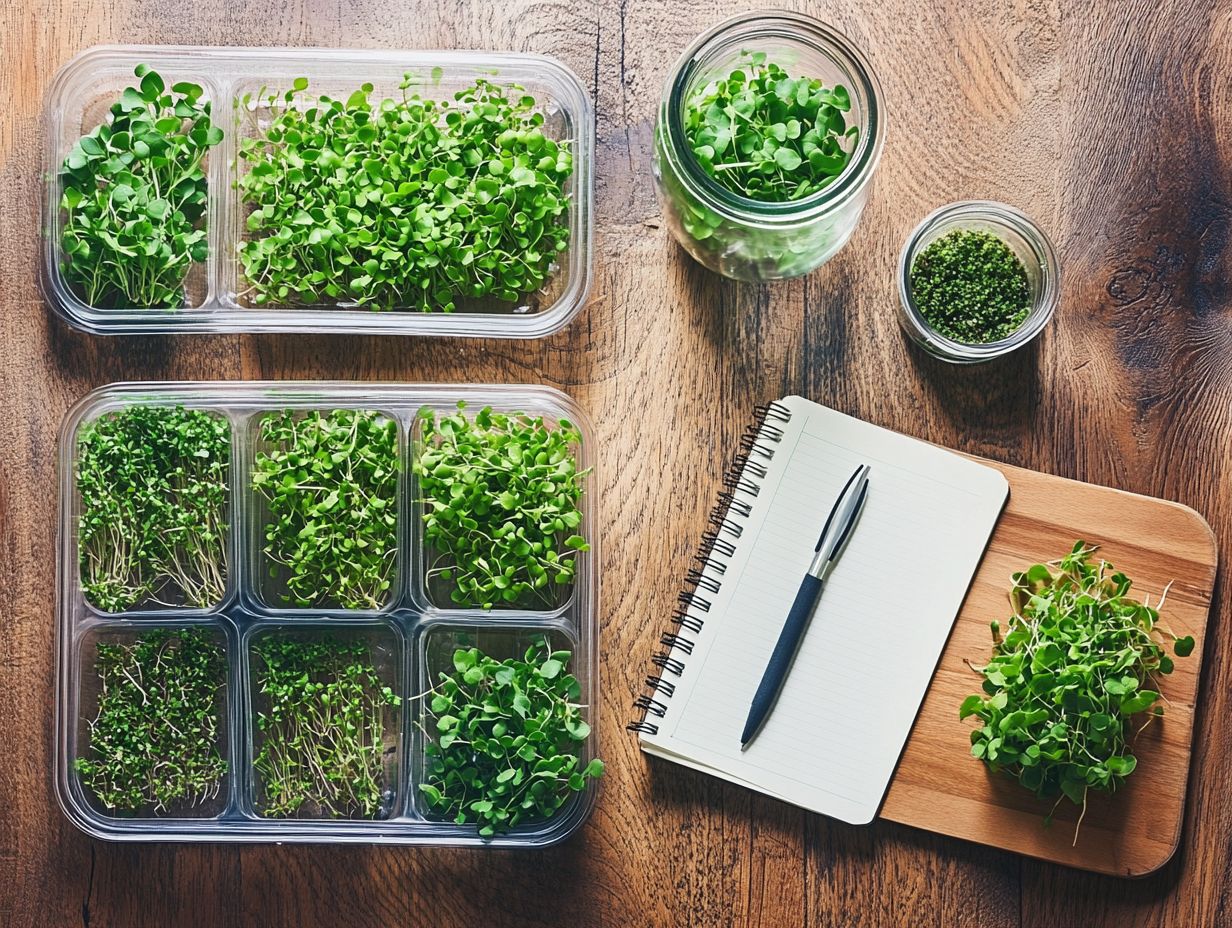
- Store microgreens in a cool, dark place with good airflow to keep them fresh.
- Each microgreen species has unique storage needs; for example, herbs and leafy greens can be stored like other greens, while root vegetables like radishes require a humid environment.
- Get creative with storage! Try alternative methods such as sprouting jars, vacuum-sealing, or refrigerator storage to prolong shelf life by handling microgreens properly.
Why Proper Storage is Important
Proper storage of microgreens is essential for keeping them fresh, retaining their nutritional value, and extending their shelf life. These greens are packed with vitamins and antioxidants! When stored incorrectly, microgreens can quickly lose vital nutrients, fade in flavor, and spoil far too soon.
Understanding how environmental factors, like the natural gas released by fruits that can cause other produce to spoil faster and moisture levels, can significantly enhance the quality and longevity of these superfoods. This allows you to enjoy their full nutritional benefits!
Whether you’re a home gardener or a culinary enthusiast, mastering the art of microgreen storage and harvesting them sustainably can lead to a more enjoyable experience with these nutrient-rich greens.
To optimize storage conditions, keep your microgreens in a cool environment, ideally between 32 F and 41 F. Be mindful of high moisture levels, as they can encourage mold growth. Using breathable containers, such as plastic ones lined with a paper towel, can help maintain the right humidity. Additionally, exploring microgreen varieties can enhance flavor and freshness.
It’s crucial to keep your microgreens away from fruits and vegetables that emit ethylene gas, such as bananas and tomatoes. This gas can speed up spoilage and diminish their flavor profile. To enhance your knowledge of the best microgreen varieties for sprouting, placing a damp paper towel in the storage container can help regulate moisture without making the greens soggy.
Regularly checking for signs of spoilage will ensure that every bite remains as nutritious and flavorful as possible. This allows you to enjoy the full benefits of these vibrant greens and their rich antioxidants!
Basic Storage Guidelines for Microgreens
To store microgreens effectively, adhere to some essential guidelines that ensure their freshness and extend shelf life.
Choose suitable containers, like plastic ones lined with a paper towel, to absorb excess moisture. This helps maintain the ideal moisture balance while storing microgreens. Ensuring adequate airflow around the microgreens is also crucial, as it prevents condensation that can lead to spoilage.
By following these practices, you can significantly extend the shelf life of various microgreen varieties, from kale to arugula and mustards, all while preserving their nutritional value.
Temperature and Humidity Requirements
The temperature and humidity levels are crucial for storing microgreens, directly impacting their freshness and quality. Ideally, keep them in a cool, dark space with temperatures between 34-40 F (1-4 C) to minimize spoilage. Managing humidity is equally important; too much moisture can invite mold, while too little might leave your greens wilting. Understanding these requirements helps ensure your microgreens, like sunflower shoots and pea shoots, stay vibrant and nutrient-rich.
Take arugula microgreens, for example. They thrive in slightly higher humidity, around 65-75%, which helps retain their crispness and flavor while boosting their nutrients. In contrast, brassica varieties such as broccoli or radish prefer drier conditions to prevent moisture that can lead to bacterial growth.
Monitoring moisture levels is easy with a hygrometer, a device that measures moisture levels. It allows for quick adjustments as needed. Storing these microgreens in vented containers promotes airflow, reducing standing moisture and maintaining a balanced environment. This not only extends their shelf life but also guarantees a delightful culinary experience whenever you reach for them.
Storing Specific Microgreen Varieties
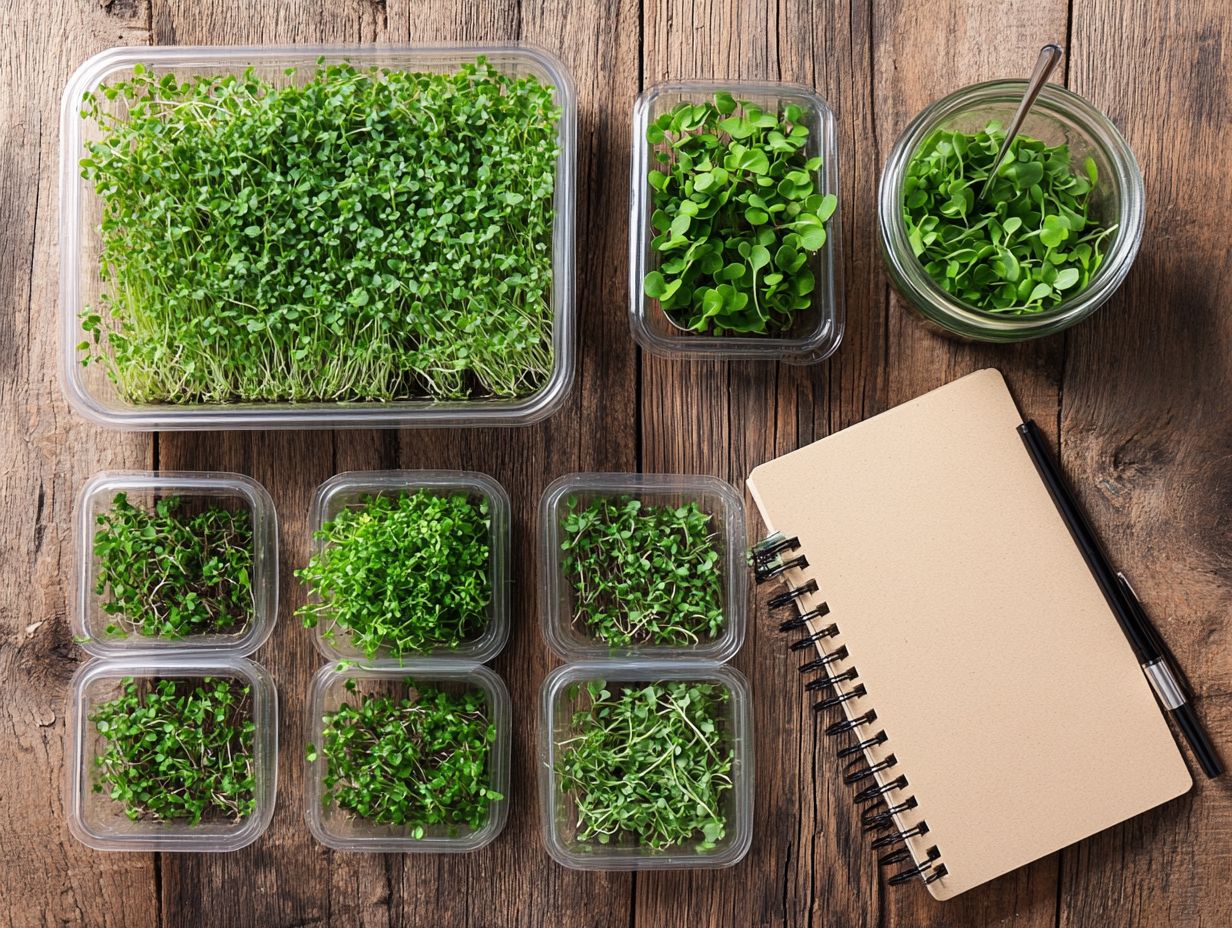
Different microgreen varieties have unique storage needs that impact their freshness and shelf life. For instance, leafy greens like kale and arugula thrive under slightly different humidity levels compared to hardier options like broccoli and mustards, both requiring careful moisture management.
Recognizing these nuances is essential. Mustard microgreens, for example, thrive in drier environments to avoid ethylene exposure, a natural gas that can speed up ripening. Meanwhile, radishes and sunflower shoots prefer a moister setting, highlighting the importance of tailored storage methods. For culinary professionals, exploring different options can be beneficial, such as the microgreen varieties for culinary professionals.
By customizing your storage methods for each specific microgreen species, you can effectively preserve their nutritional value and enhance their flavor profile. Consider trying out some must-try microgreen varieties for salads to elevate your dishes even further.
Herbs and Leafy Greens
When storing herbs and leafy greens, pay close attention to moisture levels and cutting techniques. After harvesting microgreens like basil or cilantro, ensure they are well-drained and placed in a breathable container to maintain that delicate moisture balance while avoiding ethylene exposure.
It’s essential to monitor the humidity in the storage environment. Excess moisture can lead to wilting or mold growth. Consider placing damp paper towels inside the container to achieve the right humidity level without over-soaking your microgreens. Using sharp, clean cutting tools during the harvest minimizes bruising; this small trick can make a big difference in keeping your microgreens fresh! For those looking to grow indoors, explore microgreen varieties that thrive indoors.
By being mindful of temperature control, you can help these plants thrive longer. Position them away from heat sources and ethylene-producing fruits like apples or bananas, as these factors can quickly compromise their quality and freshness.
Root Vegetables
Storing root vegetables as microgreens comes with its own unique considerations to maintain freshness and extend shelf life. Unlike leafy varieties, root types like radishes require a different moisture balance to thrive, making proper storage essential.
A good method is to place them in a plastic container with a damp paper towel, helping them stay crisp without becoming soggy. By storing them in a cool environment, you can help these microgreens retain their crunch and nutritional benefits while preserving their unique flavors. Additionally, exploring the benefits of growing diverse microgreen varieties can enhance your gardening experience.
Choosing the right containers, such as plastic containers, is vital for effective storage. Opaque containers protect your microgreens from excessive light that may cause wilting. For more information on selecting the best options, refer to microgreen varieties that suit your needs. Additionally, vented lids are also a smart choice, as they allow for necessary airflow, helping to regulate humidity levels. Balancing moisture is key—too much humidity can lead to mold growth, while too little can cause wilting.
By monitoring the condition of the paper towel and adjusting the moisture as needed, you greatly enhance the overall quality and flavor of these nutrient-packed greens, ensuring they remain a delicious addition to any meal.
Creative Ways to Store Microgreens
Exploring creative storage solutions for microgreens can significantly elevate their freshness and flavor. This offers home cooks a wealth of enticing options, including unique cooking methods.
Using alternative methods such as glass jars or vacuum-sealing will help retain moisture and keep ethylene exposure at bay, which is a natural gas that can speed up spoilage. Experimenting with different cooking techniques like incorporating microgreens as garnishes or tossing them into salads opens up a realm of versatility in preservation.
These strategies not only extend the shelf life of your microgreens but also inspire innovative uses across a variety of dishes, showcasing their versatility. For those looking to enhance their garden, exploring seasonal microgreen varieties for year-round growth can be highly beneficial.
Alternative Storage Methods
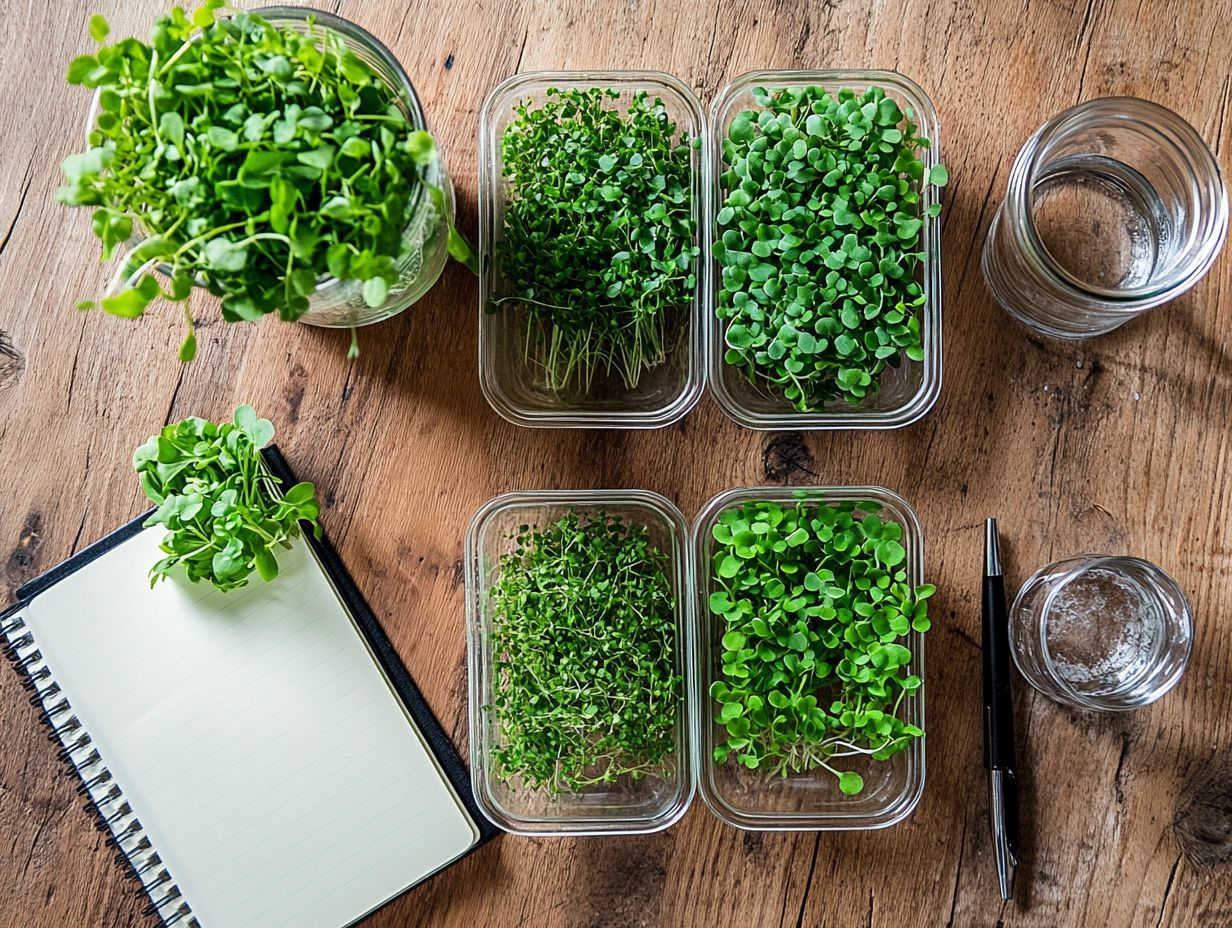
Consider exploring alternative storage methods for your microgreens that truly elevate freshness and preserve their flavor. Techniques like vacuum-sealing and using glass jars can make a remarkable difference. Vacuum-sealing works wonders by eliminating air exposure, which reduces spoilage and ethylene buildup.
Glass jars not only look elegant on your kitchen shelf but also provide an effective way to store microgreens. For those interested in growing a variety of greens, a quick guide to common microgreen varieties can be very helpful. These methods extend shelf life and allow you to assess the quality of your microgreens at a glance, helping you maintain their freshness.
Another excellent option lies in breathable produce bags made from mesh or perforated materials. These are ideal for maintaining moisture levels while allowing airflow. They help prevent wilting without trapping excess moisture, keeping the ideal moisture balance for delicate microgreens like arugula and radish sprouts.
If you value convenience, airtight containers are an intelligent choice. These containers are particularly useful for larger batches of heartier microgreens, such as pea shoots or sunflower greens. Storing them in the refrigerator keeps them crisp and ready for your salads or sandwiches.
Whichever method you choose, handle your microgreens with care to avoid bruising. This helps prevent deterioration and preserves their nutritional value.
Tips for Prolonging Shelf Life
To extend the shelf life of your microgreens, it’s essential to embrace effective handling and maintenance practices that preserve their freshness and nutritional value.
Utilizing proper techniques like washing them only before use and avoiding excess moisture during storage will significantly enhance their longevity. Regularly monitoring moisture levels and adjusting storage conditions ensures optimal freshness while preventing spoilage.
Proper Handling and Maintenance
Proper handling and maintenance of microgreens are essential for preserving their freshness and nutritional value. Gentle washing and careful handling ensure that the delicate leaves remain unbruised and retain moisture, preventing rapid spoilage.
By maintaining optimal humidity and temperature levels during storage, you can help microgreens, such as kale and radishes, keep their vibrant flavor and satisfying crunch.
Make sure to dry them well after washing, as excess moisture can encourage mold growth, compromising their quality. Storing microgreens in breathable containers allows for proper air circulation, reducing the risk of dampness while promoting a longer shelf life. For those looking to explore different options, check out microgreen varieties: a guide for beginners.
Regularly inspecting your greens for any signs of decay enables you to address issues promptly. This ensures the remaining microgreens stay vibrant and healthy. By following these handling techniques, you can savor the peak flavor and nutrition these tiny powerhouses provide, effortlessly enhancing your meals.
Frequently Asked Questions
How do I store different microgreen varieties?
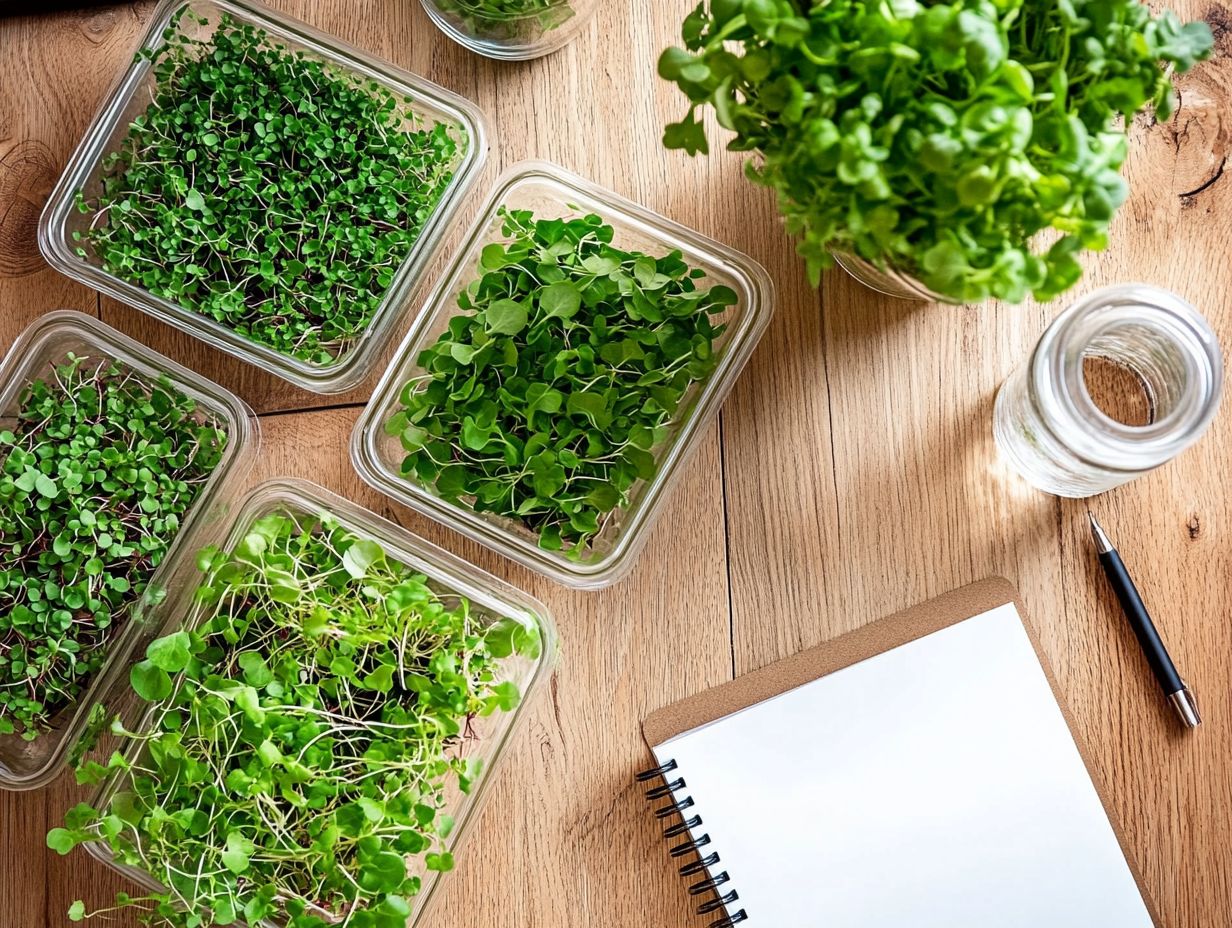
To store different microgreen varieties, first, harvest them at the right time. Then wash them and make sure they are dry before storing them in an airtight container or plastic bag with a paper towel to absorb any excess moisture. Finally, place the container in the refrigerator and use within a week for best results. Happy gardening!
What is the best way to store delicate microgreen varieties?
Store delicate microgreen varieties like cilantro or parsley in the refrigerator. Use a container with a lid or cover them with plastic wrap to keep them fresh.
Can I freeze different microgreen varieties for storage?
Freezing microgreens is not a good idea. They will lose their texture and flavor, so use them fresh or store them in the refrigerator for a short time.
What should I do if my microgreen varieties are starting to wilt?
If your microgreens start to wilt, place them in a bowl of cold water for a few minutes. After rehydrating, dry them thoroughly and store them in the refrigerator.
How long can I store different microgreen varieties?
Storage time for microgreens varies based on the type and their freshness when purchased. Generally, they last up to a week in the refrigerator, but for the best flavor, use them as soon as possible.
Are there any special considerations for storing spicy microgreen varieties?
Store spicy microgreens like radish or mustard greens separately. Their strong flavors can affect other greens, so use them within a few days for the best taste.


